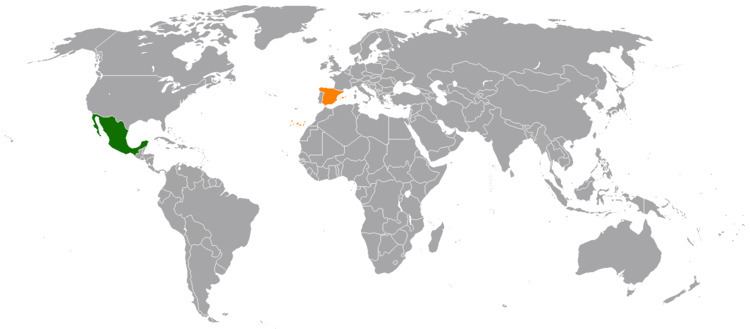 | ||
Mexican–Spanish relations refers to the bilateral relations between the United Mexican States and the Kingdom of Spain. Like many other Latin American nations, despite having achieved independence, Mexico retains a fairly strong and stable relationship with Spain. Both nations are members of the G-20, Organisation for Economic Co-operation and Development, Organization of Ibero-American States and the United Nations.
Contents
Spanish conquest
The Spanish conquistador Hernán Cortés led an expedition to what is now Mexico in 1518, establishing the city of Veracruz on his arrival. Tenochitlan, the capital of the Aztec Empire, fell to Spain in 1521. It was renamed Mexico City, the capital of the Viceroyalty of New Spain. The Viceroyalty had a stratified social hierarchy on race, with the peninsulares (people born in Spain) on top, who had the most civil rights in New Spain.
Mexican War of Independence
The late 18th and early 19th century saw much revolutionary feeling in the countries of Western Europe and their colonies. The feeling built up in Mexico after the occupation of Spain by the French Revolutionary Emperor Napoleon in 1808, and the 1810 Grito de Dolores speech by Mexican Catholic priest Miguel Hidalgo y Costilla against Spanish rule is widely recognized as the beginning of the Mexican War of Independence.In 1811, Hidalgo was executed by the Spanish militia, but his movement fought on until the establishment of the independent constitutional Mexican Empire in 1821, following the Treaty of Córdoba. The Empire was ousted and the first Mexican Republic created in 1823.
Early relations
Spain established diplomatic relations with Mexico on 26 December 1836 (15 years after Mexico had declared its independence). In the beginning, the diplomatic relationship between the two nations was strained due to Mexico having been a former colony of Spain and the latter's unsuccessful endeavors to reconquer its former colony in the ensuing years under General Isidro Barradas.
Spanish Civil War
During the Spanish Civil War (1936-1939), Mexico had provided arms and refuge to political refugees. Throughout the war, Mexican volunteers joined the Republican side to fight Francisco Franco. In 1939 when Francisco Franco took power in Spain, Mexico severed diplomatic relations between the two nations and provided $2,000,000 in aid and material assistance, which included 20,000 rifles and 28 million cartridges and a small number of American-made aircraft to the Republicans. After the war, thousands of Spanish refugees sought asylum in Mexico and former Mexican consul in Marseille, France, Gilberto Bosques Saldívar, issued thousands of visas to Spanish refugees and other asylees to seek refuge in Mexico. Though the Republicans had lost the war, this helped improve the relationship between the two countries after the death of Franco. Mexico and Spain re-established diplomatic relations on 28 March 1977.
Present day
Mexico and Spain share close and warm diplomatic relations today. On several occasions, both countries had supported each other diplomatically and there have been several high level visits and meetings between both governments including with the Spanish Royal Family. Soon after re-establishing diplomatic relations 1977; Spanish President Adolfo Suárez paid an official visit to Mexico, the first ever by a Spanish head of government. That same year, in October 1977, Mexican President José López Portillo paid an official visit to Spain. Both countries' relationship continue to be based on deep-rooted cultural similarities, such as through surnames of Spanish origin and a shared linguistic heritage.
State visits
Presidential visits from Mexico to Spain
Royal and Presidential visits from Spain to Mexico
Trade relations
In 1997, Mexico signed a free trade agreement with the European Union, of which Spain is a member. In 2016, two-way trade between both nations amounted to $7.7 billion USD. Mexico's exports to Spain include: crude oil, medicine, alcohol, fish and mobile phones, among other things; while Spanish exports to Mexico include: vehicles, vehicle parts and wine. Mexico is Spain's biggest trading partner in Latin America and 15th biggest globally
Several prominent Spanish multinational companies operate in Mexico, such as: Banco Bilbao Vizcaya Argentaria, Santander Group, Telefónica and Zara; while several multinational Mexican companies operate in Spain, such as: ALFA, Cemex and Grupo Bimbo.
